 This information has been archived for reference or research purposes.
This information has been archived for reference or research purposes.
Archived Content
Information identified as archived on the Web is for reference, research or recordkeeping purposes. It has not been altered or updated after the date of archiving. Web pages that are archived on the Web are not subject to the Government of Canada Web Standards. As per the Communications Policy of the Government of Canada, you can request alternate formats on the "Contact Us" page.
International Cooperation
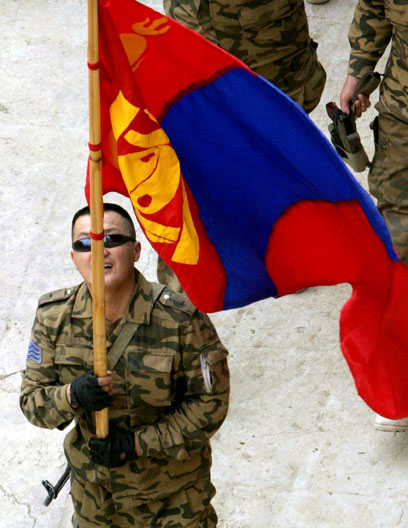
Reuters RTXMDQ3 by Alexander Demianchuk
A Mongolian soldier holds his country’s flag high during a change of command ceremony in Babylon, Iraq, 11 January 2004.
The Military Training assistance program (MTAP): merging interests of mongolia and canada
by Colonel Jargalsaikhan Mendee
For more information on accessing this file, please visit our help page.
Introduction
Besides similarity in terms of terrain, extreme climates, and sparse population, Mongolia and Canada have shared values of liberal democracy and free-market economy, as well as a common strategic interest in maintaining regional security and stability via a multilateral approach. In previous decades, Mongolia was a stronghold of the socialist camp in Inner Asia, and had served as a strategic ‘buffer state’ between China and Russia. The military was heavily indoctrinated by communist ideology, and, at the same time, it was built upon Soviet military doctrine and strategy to interoperate with Soviet military units, both in Mongolia and in the Russian Far East.1
After a surprisingly peaceful initial transition toward democracy in the late 1980s, in comparison with what occurred in former socialist countries in East and Central Europe, the Mongolian people set a democratic political structure in place, and chose a free market economy under the 1992 Constitution.2 The new parliament passed numerous legal acts, including defence legislation, which laid the legal basis for establishing a professional-oriented military force with a great respect for the principles of liberal democracy and democratically elected civilian leadership.3 Under civilian leadership since 1996, the Mongolian military strives continuously to increase participation in UN and other coalition peace operations. It has transformed its former training site into a Regional Peacekeeping Training Center in order to advance Mongolia’s profile in the international arena, and to build confidence among regional militaries.4 With respect to Mongolia’s determined commitment to international peacekeeping operations, its military has encountered challenges of language, along with tactical and operational differences regarding peacekeeping operations. The United States and Belgium were the only Western nations that initially assisted Mongolia to overcome these challenges, which proved to be immense and costly.
Following in the footsteps of the Canadian Government, the Government of Mongolia pledges to increase Mongolia’s participation in United Nations’ peacekeeping and peace support operations, which has raised Mongolia’s political profile in the international arena, and will further justify the existence and training of Mongolia’s armed forces. In 2002, Mongolia dispatched its first two military observers to the UN peacekeeping mission in the Democratic Republic of the Congo. The following year, Mongolia joined coalition operations in Iraq by deploying a reinforced company, as well as a mobile training team, to support coalition operations in Afghanistan.5 To date, Mongolia has sent military observers to MONUC (UN Organization Mission in the Democratic Republic of the Congo), MINURSO (UN Mission for the Referendum in Western Sahara), UNMIS (UN Mission in the Sudan), UNMEE (UN Mission in Ethiopia and Eritrea), and UNOMIG (UN Observer Mission in Georgia). It has also sent military contingents to UNMIL (UN Mission in Liberia), as well as to Iraq for coalition operations in Operation Iraqi Freedom (OIF), and has participated in the Afghan National Army (ANA) training mission in Afghanistan, and KFOR in Kosovo. It has tripled its number of peacekeepers in less than five years.
After a successful completion of 10 rotations in Iraq, Mongolia is now considering broadening its contribution to Afghanistan by deploying military personnel with contingents from the US and Germany, as well as with Belgium.6Thus, the Mongolian military continues to be a reliable, steadfast partner for UN or coalition peace operations.
Similar to current Canadian military policy, the leadership of the Mongolian military plans to rotate all deployable personnel through peace support operations in order to increase readiness and to spread operational and tactical experience from current operations throughout its armed forces.
Canadian Interest in Mongolia
Canada’s stake in Mongolia is growing, although Mongolia gets less attention in Ottawa, due to the lack of a substantial Mongolian immigrant community in Canada, as well as the geographic distance, which precludes close political and economic ties. The two nations first established bilateral ties in November 1973, and, during the late 1990s, Canada became one of the foremost Western nations supporting Mongolia’s commitment toward democracy and a free market economy.
With Mongolia’s determined move toward integration with the Asia Pacific region, and continued support for Canada’s initiatives for multilateral cooperation and global stability, the foreign policy interests of both nations have merged toward some of the same goals. The Canadian government supported Mongolia’s integration into such regional organizations as the ASEAN Regional Forum and other Track II events in the Asia Pacific region. In turn, the Mongolian government has supported Canada’s international efforts. For instance, Mongolia has taken phased steps toward joining the Convention on the Prohibition of the Use, Stockpiling, Production and Transfer of Anti-Personnel Mines and on Their Destruction.7
The proximity of Mongolia to China’s energy-starved market and its own rich mineral deposits have already attracted a large number of Canadian mining companies. These economy-driven interests encourage more political leverage from the Canadian government, and will eventually inspire more active cooperation in political as well as cultural spheres with Mongolia. Although Mongolia’s annual trade volume with Canada is less than US$180 million, Canada has become the second largest investor in Mongolia, accounting for 12.4 percent of total foreign investment. Since 1996, Canada has invested primarily in the mining sector (US$250 million), and 60 mining companies have commenced operations in the country.8 Reinforcing this rising economic interest, the Government of Canada opened its Embassy in Ulaanbaatar on 2 September 2008.9 This decision brought increased hope for broad cooperation between Mongolia and Canada.
Compared to economic cooperation, bilateral ties in the security and defence arena are new, and they have been carefully crafted by both sides, due to the sensitive geo-strategic location of Mongolia. Therefore, Canadian assistance to the further development of the Mongolian military’s peacekeeping capacity could be seen as the main justification to broaden the bilateral defence ties.10
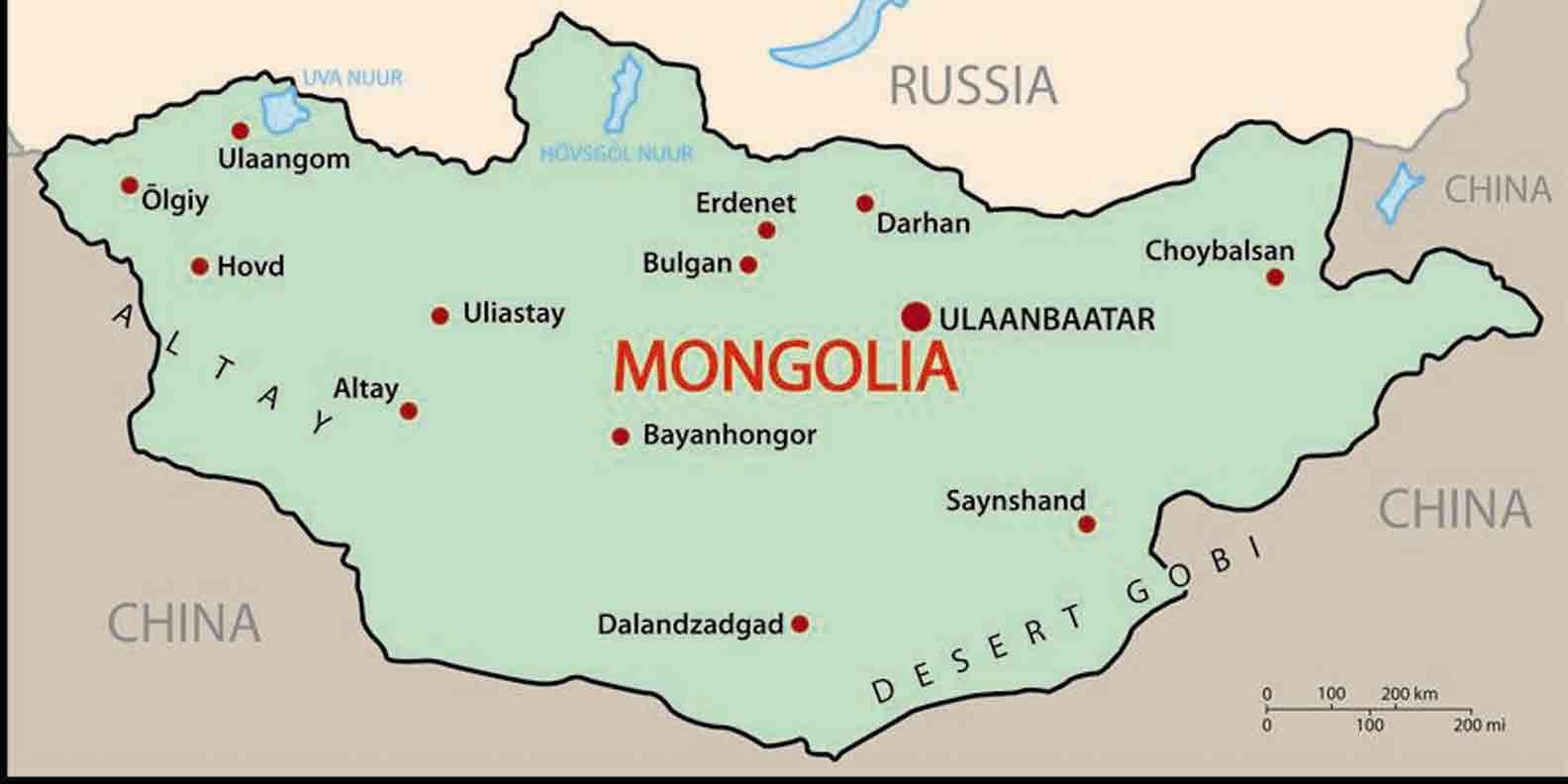
17 Wing
Defence Ties – Canada and Mongolia
The official bilateral defence tie between the two nations was established in 1996 through the initiatives of both countries. As a result, defence attachés were cross-accredited from Washington and Beijing respectfully. Both nations spent years in determining common areas for cooperation. From the Canadian side, there was the need to obtain funding and support from National Defence Headquarters because, traditionally, Canada has been heavily engaged with NATO operations in the Balkans, and it is still focused upon its more traditional regions, Latin America and Africa. However, since 1996, the respective defence attachés have fought to include Mongolia in the Canadian Military Training and Assistance Program (MTAP).The first batch of Mongolian officers participated in training courses in Canada upon the completion of the Memorandum of Understanding between the Ministry of Defense of Mongolia and the Department of National Defence of Canada concerning the Military Training in Canada of Personnel of the Armed Forces of Mongolia, signed on 20 March 2004 during the Mongolian Presidential visit to Canada.
Bilateral discussions between defence leaders have been rare, but it is worthwhile to mention that meetings between the respective defence leaderships have been set up during regional events, such as the Chief of Defence Conference of the Asia Pacific Region sponsored by the US Pacific Command, and the Defence Ministerial Conference, during the annual Shangri-La Dialogue in Singapore.11
At the ‘military-to-military level,’ the first engagement occurred in Afghanistan between the Mongolian and Canadian military when Mongolian artillery trainers were stationed at the Canadian-run base Camp Julien just outside Kabul. Here, the Mongolian military became familiar with the rules of engagement, organization, structure, equipment, and other aspects of the Canadian Forces serving in Afghanistan. According to Mongolian team members, “…officers and non-commissioned officers of both nations shared their military culture and learned rules of engagement at the Canadian base in Afghanistan...most importantly, they interoperated for the first time at the tactical level…”12
In March 2001, two Mongolian military officers, along with an official from the Ministry of Foreign Affairs of Mongolia, conducted the first-ever roundtable discussion with Canadian National Defence and Foreign Affairs Ministry officials in Ottawa., the “Mongolian-Canadian Security and Peacekeeping Seminar.” They also visited the Pearson Peacekeeping Centre and the Peace Support Training Centre in Kingston.13The event was truly an ‘eye-opener’ for the Mongolian decision-makers to help in understanding the value of peace support operations and peace support training centres. These visits to the training centres helped the Mongolian side gain a better understanding of the importance of such centres at both levels (political-strategic and tactical), and eventually some of findings appeared in the initial drafts for the Mongolian Peacekeeping Training Center. The second bilateral seminar was organized six years later in Ulaanbaatar, 22-29 October 2007, when Canadian experts shared their thoughts on peace support policy, peace support training programs, peace support training centres, and peace support battalion task organization with their Mongolian counterparts.14
In 2006, Canadian experts accepted Mongolia’s invitation to the Multinational Peace Support Operations Exercise, Khaan Quest, and the Canadian Expeditionary Command dispatched two officers to the command exercise. Additionally, Canada’s Peace Support Training Centre sent two observers to the Khaan Quest field training exercise, conducted 5-25 August 2006. This exercise provided wonderful opportunities for the Canadian team to understand the possibility of exploiting the training venue for future bilateral or multilateral training, and it also reinforced the growing need for interoperability in peace support operations.15 Due to ‘overstretch’ and strain upon the Canadian Forces in Afghanistan, CF participation in the following year’s Khaan Quest exercise was limited to observers, but it is quite likely that training events in East Asia might gradually attract the participation of the Canadian Forces in the long run.
Another emerging area of mutual interest is academic cooperation between defence educational institutions, such as the Canadian Defence Academy and the Royal Military College. Clearly, Mongolia’s military needs to develop a comprehensive approach to peace support operations in terms of education and training, and it needs to circulate the knowledge and experience accumulated in the last several years in more efficient ways. Bearing this in mind, the Canadian Defence Academy could help the higher academic institutions of the Mongolian military (the Institute for Defense Studies and the Defense University) reform their research activities, as well as their research methodology. The visit of Dr. Jim Barrett and Dr. Joel Sokolsky of the Canadian Defence Academy/Royal Military College of Canada to Ulaanbaatar in 2007 prompted both sides to encourage academic cooperation between the two institutions, and to learn from Canadian experience with respect to research and dissemination in the field of peace support operations and regional studies.16 As a result of this visit, Dr. David Last, a professor of the Department of Political Science at the Royal Military College, worked at the Peacekeeping Department of the Mongolian Defence University, and exchanged his views with Mongolian counterparts in July 2008.17 All these visits were funded under MTAP.
One of the highlights of bilateral relations was the first-ever visit by a Canadian DND official, Andrew P. Rasiulis, Director of Canada’s MTAP, who paid an official visit to Mongolia on 25-29 March 2007. During the visit, he met Mongolian defence leaders as well as Mongolian graduates from MTAP courses, and he examined the training needs and requirements of the Mongolian military. As stressed by Rasiulis, “…MTAP plays a key role in promoting Canadian defence and foreign policy interests worldwide among a selected group of developing non-NATO countries…”18 The Military Training and Assistance Program has become a vital instrument of defence diplomacy between Mongolia and Canada.
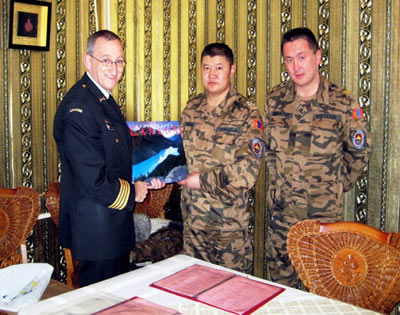
Author’s photograph
Canadian Defence Attaché Colonel Chris Weicker meets Mongolian MTAP graduates at Peacekeeping Unit 330 in Darkhan, Mongolia, March 2008.
MTAP Offers New Opportunities
As mentioned earlier, it took until October 2004 to include Mongolia in MTAP as a ‘Tier-One’ country. Prior to its acceptance in MTAP, Mongolia was invited to send two military officers to the English Language Training Course in St. Jean Québec as a test case. As a result, Major Narantulga and Captain Baatar became the first Mongolian officers to complete the English Language Training Long Course in Canada. After this training, they both served as UN military observers in the Congo, and commanded Mongolia’s rotations in Iraq and Sierra Leone.19
MTAP provides both an excellent environment for Mongolian military personnel to learn the complexity of contemporary peace support operations, and a venue for understanding Canadian culture and civil-military relations during training in Canada. In comparison with earlier participants, the current batch of Mongolian military personnel so deployed have brought their unique experience in coalition operations in Iraq, Afghanistan, Sierra Leone, and Kosovo to their course colleagues, and have contributed their thoughts on how to overcome operational challenges for coalition and multinational operations.20The Mongolian graduates from MTAP are all needed for both domestic and multinational operations. They have been playing key roles in either planning and formulating peace support operations policy and training, or in conducting peace support operations missions abroad.21
Beginning in 2006, Canada invited Mongolia to send officers to the National Security Studies Seminar, Senior Management Courses on Integrated Peace Missions, the Defence Resource Management Seminar, and the Civil-Military Relations Seminar. These courses enabled Mongolian officials and researchers to explore democratic civil-military relations, and to garner Canadian insights on security studies and defence resources management. Due to the size and nature of civil-military relations, the Canadian model and experience are more applicable than the US model for developing countries like Mongolia, as the American model is based upon an immense structure.
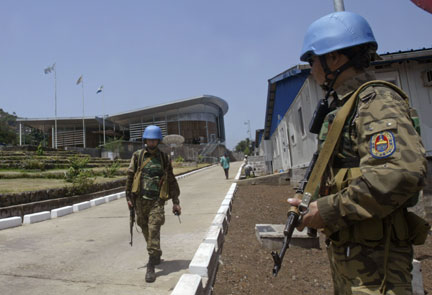
Reuters RTR1C27E by Luc Gnago
UN soldiers from Mongolia stand guard outside the Special Court for Sierra Leone in Freetown, 31 March 2006.
The Way Ahead
Based upon merging interests of Mongolia and Canada, bilateral ties in terms of defence and security are more promising, given Canada’s expertise in and Mongolia’s need for capacity building regarding peace support operations. The Military Training and Assistance Program will “…promote Canadian foreign and defence policy interests, promote Canadian bilateral defence relations, raise Canada’s independent national profile as a valuable player in the international arena, build peace support operations capacity among Canada’s peacekeeping partners, promote democratic principles, the rule of law, the protection of human rights and international stability…” in Mongolia.22
There are number of areas where Canada and Mongolia could cooperate:
Provision of increased training opportunities for Mongolian military in all pillars of MTAP (language, peacekeeping-military, advanced courses in civil-military relations, defence resource management, security studies) with the aim of developing a similar self-sustaining training course in Mongolia;
Development of a joint research capacity on certain issues of mutual interest, such as the development of a model for peace support operations capability in developing nations, regional security issues (North Korea, a growing China, etc. ), and contemporary civil-military relations comparable with those in the Americas;
Exploitation of training opportunities/venues in Mongolia to organize both the specific bilateral training (Long-Range Patrolling, etc.) and multilateral training events (UNMO courses, exercises, etc.) for the North East Asian countries, noting that Mongolia could provide a neutral forum for regional countries;
Development of the peace support operations capacity, with an aim to increase the interoperability and effectiveness of Mongolian forces for future coalition operations, noting that Mongolia was a steadfast partner of the United States in the Global War on Terrorism by deploying credible forces to Iraq and Afghanistan;
Assistance in development of a comprehensive strategy for peace support operations deployments, capacity building, and strengthening the educational and training programs and facilities, as well as provision of political support for Mongolia to participate in United Nations Peacekeeping Operations; and,
Increased exchanges of military and research personnel, and bilateral consultation on mutually interested issues, as well as defence cooperation issues. Initially, the need is to manage MTAP, as well as in-country training, for peace support operations.
Conclusion
Canada’s growing economic interests in Mongolia, in line with the similarities in foreign policy, will provide a favorable atmosphere to develop bilateral defence cooperation solely aimed at peace support operations. The Military Training and Assistance Program provides excellent opportunities to increase Mongolia’s capability of peace support operations, and, at the same time, advances mutual understanding and friendship between militaries of two nations for future common goals of international security.
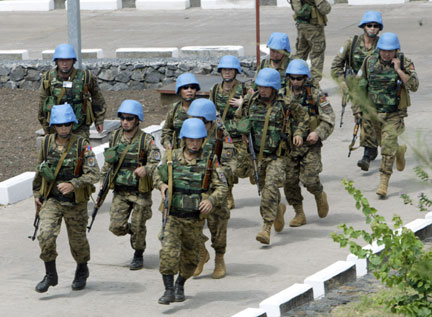
Reuters RTR1C5MW by Luc Gnago
Mongolian soldiers on patrol in the yard of the Special Court, Freetown, Sierra Leone, 3 April 2006.
![]()
Colonel Mendee is a former Mongolian Defence Attaché to Canada and is now the Senior Research Fellow at the Institute of Strategic Studies of Mongolia.
NOTES
- Under the governmental agreement between Mongolia and USSR in March 1967, a substantial Soviet military presence was stationed in Mongolia. Between 1987 and 1992, the USSR withdrew 82,000 personnel, along with 1866 tanks, 2531 armored vehicles, 315 fighters and helicopters, and 1416 artillery systems from Mongolia. A Concise History of Mongolian Military ( Ulaanbaatar: NP, 1996), pp. 495-496.
- The Constitution of Mongolia, (Ulaanbaatar: State Great Hural [Parliament], January 1992). Under the 1992 Constitution, Mongolia’s political structure became a hybrid structure with a strong Parliament, which appoints the executive body (the Prime Minister and his Cabinet), and a symbolic President, who has a ‘checks and balances’ power over the executive branch, and an independent judiciary.
- Similar to defence reforms in developing nations, the defence legislation separated the Ministry of Defense and the General Staff of the Armed Forces, introduced a political appointee as a defence minister, and set a goal of reforming the military as a “…compact, capable, professional oriented” force.
- See the Action Plan of the Government of Mongolia for 2004-2008 (Ulaanbaatar: 2004), Mongolian Defense White Paper (Ulaanbaatar: 2001), and also the Basis of the State Military Policy [Doctrine] (Ulaanbaatar: State Great Hural, 1998). In the Armed Forces Development Plan until 2015, the Government aimed to establish a 2500-man peace support operations stand-by brigade, to develop niche capabilities (such as military police, medical mobile team, chemical and engineering detachments), and transform the current military training centre as a Regional Center of Excellence in Peace Operations.
- Mongolia has demonstrated to the United States that it is a potential ally for coalition missions, starting with its deployment to Iraq. Due to similarities of weapons systems, Mongolian Armed Forces dispatched a Mobile Training Team to Afghanistan to build up Afghan National Army artillery units. Despite language difficulties, Mongolian trainers managed to operate in Afghanistan, and the US Central Command consistently welcomed Mongolian trainers in other areas.
- Interviews with Officials of Ministry of Defense and Ministry of Foreign Affairs and Trade of Mongolia, 10 June 2009.
- The Government of Mongolia declared its support of the Ottawa Convention, with phased commitments not to transfer anti-personnel mines, and to disclose the number and location of mines.
- The Bilateral Relations Report Notes of the Ministry of Foreign Affairs of Mongolia.
- Website of the Embassy of Mongolia in Canada. Available Online: http://www.mongolembassy.org/?q=en/node/50 23 June , 2009.
- Both the Russian Federation and the People’s Republic of China are consistently wary with respect to Mongolia’s security and defence engagements with the United States and other NATO member countries. Hence, the United States agrees to support Mongolia’s intention to develop “…the world-class peacekeeping force,” and to pursue a policy that will not disturb Mongolia’s relations with her neighbours. Based upon Canada’s vast experience in UN peacekeeping operations, along with a multilateral foreign policy approach, Canada’s bilateral cooperation with Mongolia in the defence field eases both neighbours’ concerns.
- Meetings between the Mongolian Chief of General Staff and Chief of the Defence Staff General Raymond Henault (2 November 2002, CHOD conference in Singapore, 2 October 2003, CHOD Conference, in Hawaii) and Chief of the Defence Staff General R. J. Hillier (25 October 2005, CHOD conference, Hawaii), as well as H.E. Sonompil’s meeting with Deputy Minister of National Defence Ward P. D. Elcock at the Shangri-la Dialogue in 2006 in Singapore, have played a crucial role toward increasing the awareness of Mongolia’s desire to learn from Canada’s peacekeeping experience.
- Interview with Sergeant Zolbadrakh, who was stationed at the Canadian base for six months in Afghanistan.
- Mongolian participants at this seminar were Colonel Choijamts, Chief of the Strategic Management and Planning Directorate, Ministry of Defense, and Colonel Ragchaa, Chief of the Peacekeeping Department of the General Staff of the Armed Forces. Both officers have played the most crucial role in shaping Mongolia’s peacekeeping policy and activities: Major General Choijamts serves as the Chief of the Peace Support and Cooperation Department of the General Staff, and Major General Ragchaa has been posted as Military Advisor to the Permanent Mission at the United Nations.
- The second seminar helped Mongolian counterparts to understand the more technical aspects of a peacekeeping training centre and a peacekeeping battalion, as well as to understand the growing complexity of peacekeeping policy and training programs.
- Given the participation of Lieutenant-Colonel Stewart, Commandant of PSTC, and Chief Warrant Officer Wylde, (RSM of the PSTC), the exercise offered an excellent opportunity to establish contact with their Mongolian counterparts, as well as to visualize the training venue in Mongolia.
- During the late 1990s, the Institute of Strategic Studies developed close cooperation with a number of Canadian scholars from the University of British Columbia, the University of Victoria, and the Toronto-York University Joint Centre for Asia Pacific Studies,. Joint research was completed on the topics of human security, confidence building measures, arms control, and peacekeeping, and a series of conferences was organized both in Mongolia and Canada. Based upon this tradition, the defence research institutes could do joint research on peace support operations, the interoperability of coalition operations, the development of peace support operations capacity, and so on.
- Produced jointly with a Mongolian researcher, Dr. Last’s paper, Whole of Government Responses in Mongolia: From Domestic Response to International Implications, was published in the Pearson Papers, Volume 11, Issue 2, Fall 2008, pp. 1-22.
- Andrew P. Rasiulis, “The Military Training and Assistance Program (MTAP): An Instrument of Military Diplomacy,” Canadian Military Journal, Vol. 2, No. 3, Autumn 2001, p. 63.
- The Late Lieutenant Colonel Narantulga served as an UNMO in DRC, and contingent commander in Iraq. He served as a contingent commander of Mongolian forces in Sierra Leone, and he held the position of Chief of the Peacekeeping Department at the Defense University. Lieutenant Colonel Baatar served as an UNMO in DRC, and Operations Officer for both operations in Iraq and Sierra Leone. Currently, Lieutenant Colonel Baatar is Deputy Commander of the second Mongolian peacekeeping-designated battalion.
- Since 2005, the General Staff has pursued a policy of sending military personnel with peace support operations experience to Canada in order to sharpen their language skills, as well as to upgrade their military skills needed for peace support operations.
- Forty-nine Mongolian officers and non-commissioned officers completed English and French language training, peace support operations training, and other courses under the Military Training and Assistance Program in Canada. Currently, eight officers are in training in Canada.
- Directorate of the Military Training and Assistance Programme (MTAP) http://www.forces.gc.ca/admpol/content accessed on 9 March 2008.






